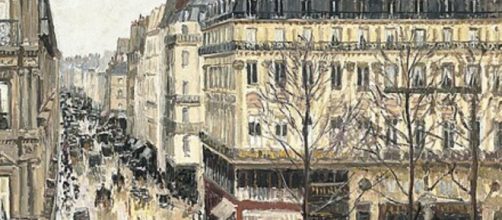When time passes, you expect change. But you don’t bargain for facts to change. Yet, weighing a new biography of Impressionist Camille Pissarro with one in 1980 change the picture.
Adam Gopnik, art critic for the New Yorker, sees the new bio – “Camille Pissarro: The Audacity of Impressionism” by French historian Anka Muhlstein – as a story of the painter’s progression “from mediocrity to magnificence.”
Required reading
Gopnik’s view would have you think that this Impressionist evolved over time from so-so to sensational. But based on the 1980 bio “Camille Pissarro: 1830-1903” by American art historian John Rewald, the artist developed self-doubts about Impressionism in the last 20 years of his life.
This is not some obscure factoid in an art history gathering dust in a college library somewhere. The NY Times called Rewald’s book “indispensable,” adding: “One way or another every scholar of late 19th century French art had to contend with his writing.”
Apparently not. If, as Gopnik says, Muhistein’s book shows Pissarro evolving from ordinary to extraordinary, then the biographer didn’t read Rewald.
And because Rewald is recognized as a specialist in Impressionism, you have to wonder how Muhistein could write a book about Impressionist without reading the “indispensable” Rewald?
Don’t art experts read art history anymore? Consider Gopnik writing this of Pissarro: “Whatever 'Impressionism' means is what he means, too.” Nope.
That’s not the way the artist spoke about himself or Impressionism in his weekly letters to his son Lucien (and cited by Rewald). Far from "father of Impressionism," Pissarro questioned the very merit of the art movement this way: “I am much disturbed by my unpolished and rough execution; I should like to develop a smoother technique which, while retaining the old fierceness, would be rid of these jarring notes which make it difficult to see my canvases clearly...”
Rewald wasn’t even the only source reporting Pissarro’s self-doubts. In 1944, The Atlantic Magazine noted the posthumously published collection of letters to Lucien, written in the last twenty years of his life.
In the artist’s own words
As his letters indicate, Pissarro also worried about his son’s zeal for modernism (abstraction) and his disregard for naturalism. In one letter, he spoke of his passion for nature: “Decidedly, we no longer understand each other. What you tell me about the modern movement, commercialism, etc. has no relation to our conception of art. According to you salvation lies with the primitives... According to me this is incorrect. Salvation lies in nature, now more than ever.”
So, art experts like Gopnik and Muhistein can talk all they want about Pissarro, but without a looksee at his letters, they’re missing who he really was.
But wait, here’s a reviewer of Muhistein’s bio who took the trouble to read Pissarro’s letters. Paul Walsh, writing for The Art Fuse, said of this new bio: “Its’ probably best read as a biography of a hard-working family man and not as a thorough assessment of Pissarro’s art.”
What he said.


